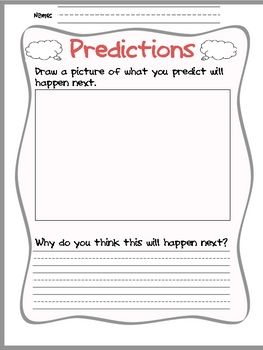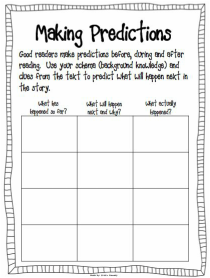What is Predicting?
Good readers make predictions as they read, to help them deepen their thinking and better comprehend what they read. Predicting is when readers use text clues and their own personal experiences, to anticipate what is going to happen next in the story. According to the article, Making Predictions (N.D.), this strategy focuses on the text at hand, constantly thinking ahead and also refining, revising, and verifying his or her predictions. In other words, it is important that students understand that as they read, their predictions may change. Students should also verify their predictions by determining if their prediction came true or not. If their prediction did not come true, or they don't think it will come true, then they may want to modify or change their prediction.
Visual Representations
Content Area Examples
Science- The strategy could be adapted in a science lesson by having the students make predictions about the weather. The teacher may keep track of the weather everyday and have the students make a prediction of what the weather is going to be like the next day. They will have to use their prior knowledge of what they weather has been like, the season, and month to help make their prediction. The next day they will have to see if their prediction comes true.
History- Predicting could be adapted in a history lesson by having the students read a chapter from their history book. They may use a graphic organizer worksheet to help them create their predictions. If they are reading about a president, they may predict what happens next in the chapter. This will help them make meaning of text and comprehend what they read.
Math- This strategy could be adapted in a math lesson by having them predict which number come next in a number sequence. For example, they may have a number sequence the consists of the numbers: 28, 38, 48, 50, 60, 70, 72... The students will need to predict what the next three numbers will be. The students will analyze the numbers and notice that it is +10, +10, +2... They will predict that the next 3 numbers in the number sequence will be 82, 92, and 94, because they add 10, 10, 2.
Reading- This strategy is often used in reading lessons. The teacher may be doing a read aloud with the students and having the students talk about what is happening in the story. After discussing what is happening the teacher would then have the students "turn and talk" about what they think is going to happen next. The teacher will then continue reading and the students will determine if their prediction came true or not. During the read aloud, the students may modify or change their prediction using clues in the text to justify why they changed their prediction.
History- Predicting could be adapted in a history lesson by having the students read a chapter from their history book. They may use a graphic organizer worksheet to help them create their predictions. If they are reading about a president, they may predict what happens next in the chapter. This will help them make meaning of text and comprehend what they read.
Math- This strategy could be adapted in a math lesson by having them predict which number come next in a number sequence. For example, they may have a number sequence the consists of the numbers: 28, 38, 48, 50, 60, 70, 72... The students will need to predict what the next three numbers will be. The students will analyze the numbers and notice that it is +10, +10, +2... They will predict that the next 3 numbers in the number sequence will be 82, 92, and 94, because they add 10, 10, 2.
Reading- This strategy is often used in reading lessons. The teacher may be doing a read aloud with the students and having the students talk about what is happening in the story. After discussing what is happening the teacher would then have the students "turn and talk" about what they think is going to happen next. The teacher will then continue reading and the students will determine if their prediction came true or not. During the read aloud, the students may modify or change their prediction using clues in the text to justify why they changed their prediction.


